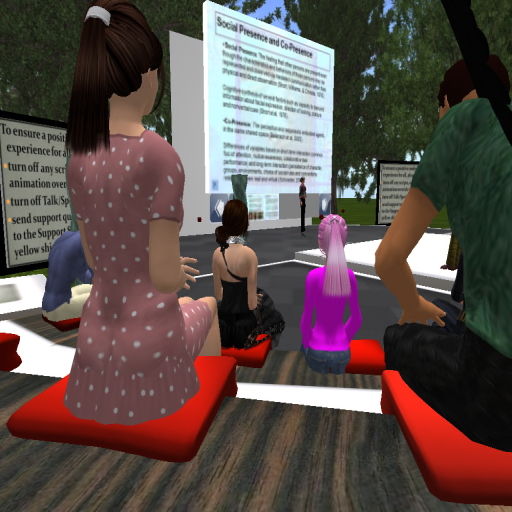
|
New Media: Using Second Life for Education |
Education is moving rapidly into the virtual space. Virtual high schools and colleges are enrolling thousands of students.

The number of e-learning courses now being taught by colleges and universities around the world in Second Life has grown into the thousands. There are complete courses delivered entirely in SL as well as auxiliary content for hybrid courses and research sites in support of traditional classrooms.
- Currently involved educationally with the virtual world Second Life are some 800-1,000 colleges, universities, libraries and library systems, museums, educational organizations such as NMC, ISTE, NECC, AECT, Eduserv, ALA, Global Kids, OLN, Sloan and many more. list of some of the colleges
Well-known universities and educational institutions using Second Life include University of North Carolina-Chapel Hill, UNC-Charlotte, UNC-Pembroke, NC State, East Carolina, Duke, Elon, South Carolina, Clemson, Tennessee, Kentucky, Louisville, Harvard, MIT, Stanford, Penn State, Iowa State, Ohio State, Ohio University, Notre Dame, Texas, Texas A&M, Air Force Air University, Clemson, Tulane, Cincinnati, Denver, Idaho, Washington, Dallas, Wright State, Hawaii, Queensland, Oxford, Liverpool, and on and on.
Here's an example. Imagining ways to improve teaching and research at all of its institutions, the University of Texas System, composed of nine universities and six health centers, purchased 49 islands in the online world Second Life. The system is allowing administrators, faculty members, researchers and students to build educational facilities of their own conception on the virtual real estate.Frequently we hear "boring" and "dry" when today's students talk about their experiences in traditional classrooms. These digital natives have been raised on the Internet and interactive games, and they have expectations that are not met entirely by the current "skill and drill" system of learning in a traditional classroom.
- Many high school teachers are observing the educational activity and yearning for access to the virtual environment, but Second Life is limited to persons 18 and older. On the other hand, there is Teen Second Life for persons 13-17.
- They bring to class new and different attitudes toward education, along with their broad array of technological skills. They ask for more than the traditional lecture format. They want authentic interactive educational experiences, like those they have found on the Internet and in video games.
- By the way, they are not looking for an easier path. On the contrary, they want greater cognitive challenges.
The virtual world Second Life provides a unique flexible platform for educators interested in distance learning, computer supported cooperative and collaborative work, simulations, faculty and staff development workshops, colloquia and symposia, and new media studies.
- It's not difficult to create a safe environment to enhance experiential learning, allowing individual students to practice skills, conduct research, simulate the real world, try new ideas, and learn from their mistakes.
- Teaching and learning in the virtual world can be an international, intercultural experience. Students and educators can work together in Second Life from anywhere in the world as part of this globally networked virtual classroom environment.
- Most disciplines can imagine teaching spaces for their content in the virtual world. Using Second Life as a supplement to traditional classroom environments provides new opportunities for enriching an existing curriculum.
Learn more about virtual worlds and Second Life:
- What is a virtual world? »
- What is Second Life? »
- How to get started in Second Life? »
- Great Places in Second Life »
- Stone Semyorka's Second Life photo collections »
- A small photo gallery of Second Life »
- Second Life on YouTube »
- Using Second Life for Education »
- The UNCP Campus in Using Second Life »
- Education on the Second Life Grid »
- Center for the Study of Virtual Worlds »
- Second Life for Business »
- How To Build in Second Life »
- Creating and developing Second Life »
- Who are the residents of Second Life? »
- Second Life: PG vs. Mature »
- Second Edition Blog »
- Second Life home page »
- News Media in Second Life »
- News of Second Life and Virtual Worlds »
- Scholarly References about Second Life and Virtual Worlds »
| The names Second Life and Linden Lab, and the hand logo and logotype, are registered trademarks of Linden Research Inc. |